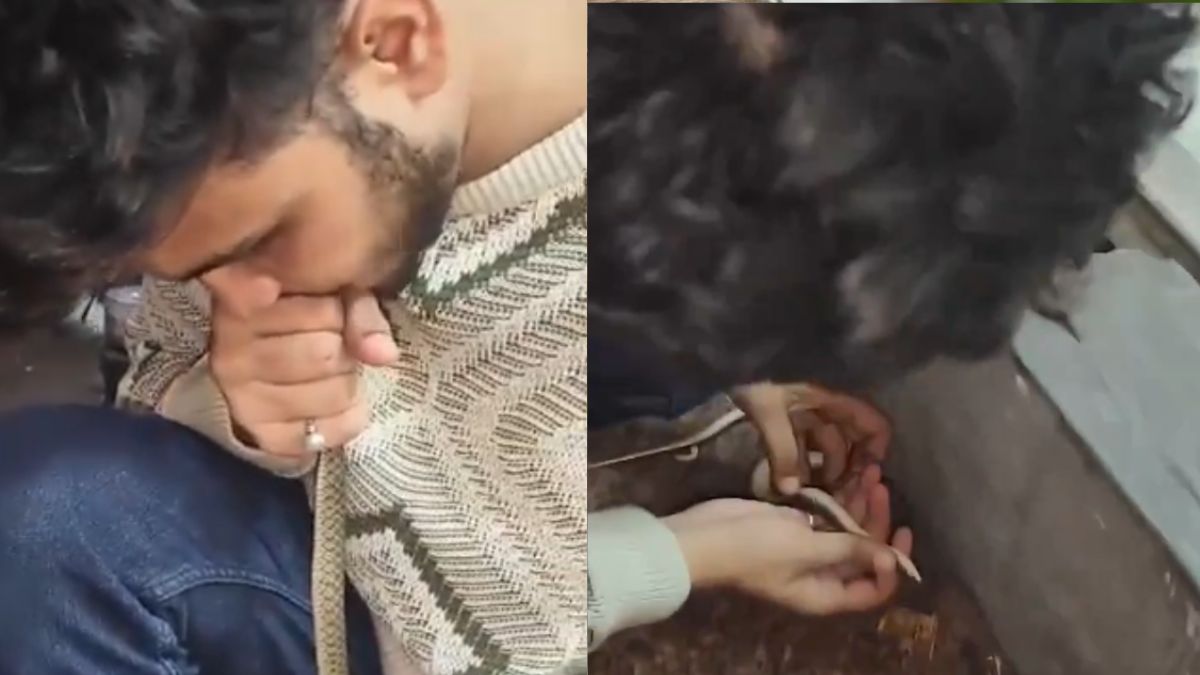The recent rescue of a seemingly lifeless snake in Vadodara, Gujarat, highlights the dedication of wildlife rescuers and the surprising resilience of nature. Yash Tadvi, a young wildlife rescuer, successfully revived a checkered keelback lizard using cardiopulmonary resuscitation (CPR), a technique more commonly associated with human medical emergencies. This extraordinary event underscores not only Tadvi’s quick thinking and expertise but also the potential for unconventional life-saving measures in the animal kingdom. The incident, captured on video and shared widely on social media, has sparked a conversation about the importance of wildlife conservation and the often-unseen efforts of individuals working tirelessly to protect vulnerable creatures. The story also serves as a testament to the unexpected adaptability and survivability found in the natural world. The snake’s subsequent handover to the forest department exemplifies the collaborative effort required for effective wildlife rescue and rehabilitation. This narrative, while focusing on a single event, raises broader questions regarding wildlife rescue practices, the role of citizen scientists, and the human-animal relationship.
The Miraculous Rescue of a Checkered Keelback
Yash Tadvi’s Heroic Actions
Yash Tadvi, a young resident of Vadodara, received a call about a seemingly deceased snake. Upon arriving at the scene, he found a one-foot-long checkered keelback in an unresponsive state. Undeterred, Tadvi’s wildlife experience and intuition told him the snake wasn’t truly dead. He initiated CPR, a highly unconventional approach for a reptile, employing mouth-to-mouth resuscitation. The first two attempts yielded no visible improvement. However, Tadvi’s perseverance paid off on the third attempt; the snake started showing signs of life and eventually recovered its responsiveness. This demonstrates not only Tadvi’s dedication but also his understanding of the reptile’s physiology enough to take a calculated risk. The procedure itself showcases the adaptability of CPR principles across diverse species.
The Significance of the Rescue
This incident carries considerable weight beyond a single successful rescue. It highlights the vital role of citizen scientists and dedicated wildlife enthusiasts in conservation efforts. Often, these individuals are the first responders to wildlife emergencies, lacking the resources of formal organizations. Tadvi’s successful resuscitation demonstrated an innovative and potentially life-saving approach to wildlife emergency response, potentially broadening the scope of rescue techniques. His quick thinking and knowledge of reptile physiology, coupled with his calm and precise execution of CPR, deserve significant recognition. The video evidence documenting this rescue further underscores the importance of recording and documenting such events for educational and research purposes.
The Checkered Keelback and its Habitat
Understanding the Species
The checkered keelback ( Xenochrophis piscator) is a non-venomous snake species commonly found in India and other parts of South Asia. While not considered a threat to humans, they often find themselves in precarious situations due to human encroachment on their habitat. These snakes are semi-aquatic, and can often be found in or around water bodies. This specific case exemplifies the increasing challenges faced by wildlife as urban environments expand, bringing humans and wildlife into closer proximity, increasing the risk of injury and mortality for the latter.
Habitat Loss and Human Interaction
Habitat loss and degradation remain significant threats to various snake populations across the globe. Increased urbanization, agricultural expansion, and other human activities lead to the fragmentation of natural habitats and subsequently expose wildlife species such as snakes to dangerous interactions with humans and increase their chance of getting injured. Moreover, humans’ fear and misunderstanding of snakes often result in needless killing or injury. The unchecked growth of human settlements contributes heavily to these problems and necessitates innovative wildlife rescue methods and preventative measures for mitigating human-wildlife conflict.
Implications for Wildlife Rescue and Conservation
Expanding Rescue Techniques
Tadvi’s successful CPR on the checkered keelback opens up a dialogue regarding the flexibility and applicability of established rescue techniques across different species. While CPR is a well-known medical procedure for humans and other mammals, its adaptation to reptiles demands careful consideration and further research. It opens up exciting prospects in expanding the knowledge and capabilities of wildlife rescuers. This case underscores the need for ongoing research and training into advanced animal resuscitation methods to improve rescue techniques in cases involving different kinds of animals.
The Importance of Wildlife Education
The public’s perception and understanding of snakes are critical for effective conservation efforts. Fear and misinformation can lead to inhumane treatment and needless harm to these vital components of the ecosystem. Comprehensive wildlife education is therefore crucial to shift attitudes and promote responsible interaction with wildlife. Educating people about the importance of respecting the wildlife environment is crucial for facilitating the peaceful coexistence between animals and people.
Take Away Points
- The successful resuscitation of a checkered keelback snake using CPR highlights the resourcefulness and dedication of wildlife rescuers.
- This event showcases the importance of citizen science and the vital role individuals play in wildlife conservation.
- The incident emphasizes the need for greater public education about snakes and responsible interactions with wildlife.
- The case underscores the potential for innovation in wildlife rescue techniques and the need for further research in animal resuscitation.
- Habitat loss and human-wildlife conflict continue to pose significant threats to snake populations.




